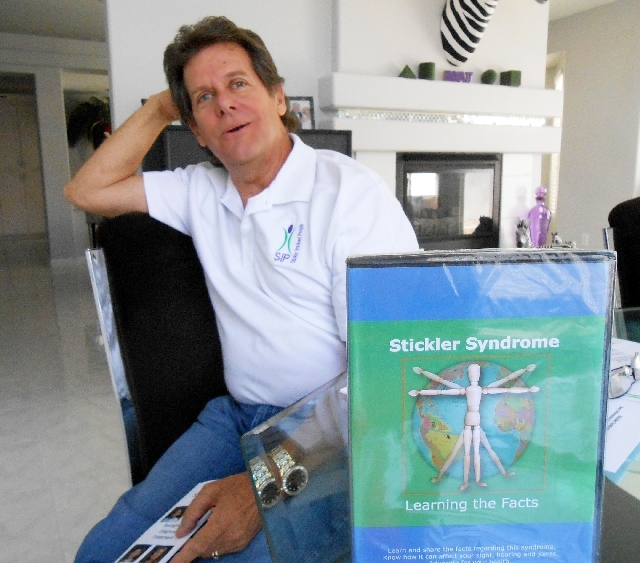Conference to gather those facing Stickler syndrome
All through school, Rick Bishop, 58, wore thick glasses for nearsightedness. As an adult, he was outfitted with two hearing aids. At 40, he had a detached retina in his left eye.
“I thought that was a little unusual,” said Bishop, who lives near Summerlin. “I had cataract surgery at 38, and now I have a detached retina. What’s going on?”
His ophthalmologist suggested that he had Stickler syndrome. It prompted him to get a definite diagnosis.
Stickler syndrome is a progressive disease that can include retinal detachments, degenerative joints, spinal abnormalities, conductive hearing loss and early-onset osteoarthritis. Fibromyalgia is another indicator. Some of those who have Stickler syndrome are born with a cleft palate, a small chin, nearsightedness, a flat nasal bridge and long fingers.
Now, Bishop is helping coordinate the 17th American Stickler Syndrome Conference, which is slated for July 12 and 13 at the Embassy Suites Convention Center, 3600 Paradise Road. The cost is $35 per family. A working lunch will be available for $20 per person. For more information, visit sticklers.org.
Two years ago, soon after moving to Las Vegas, Bishop began a Stickler chapter, which is part support group and part educational. He visits doctors’ offices and leaves printed information and a DVD, “Stickler Syndrome. Learning the Facts.”
Before his ophthalmologist’s remark, Bishop had never heard of Stickler. It was in the pre-Internet days, so he finagled his way into a medical library to learn more.
“My biggest concern was, ‘Was I going to be blind down the road?’ ‘Was I going to lose my hearing totally?’ ‘Was I going to be in a wheelchair the rest of my life?’ ” he said. “We knew it was not life-threatening, but I was worried about my health in general.”
His early research led him to Bill and Pat Houchin of Wichita, Kan., who had dealt with it. Pat Houchin said that as a toddler, her daughter exhibited signs as soon as she began walking.
“Her ankle bones almost touched the ground,” she said.
Doctors gave the Houchins a number of possibilities — flat feet, cancer of the bones and spina bifida. The family finally wound up at a geneticist, who determined that it was Stickler. After all the other possibilities that had been suggested, Pat Houchin said, the nonlethal Sticker diagnosis “was actually a relief.”
The Houchins started a grassroots effort, getting the word out about Stickler. The group’s first conference was in 1997 in Iowa City, Iowa. It included giving blood for research being done by one of the speakers, Dr. David Brown. Since then, as word has spread, more support groups have sprung up and annual conferences have been held in major cities, including Denver, Philadelphia, Chicago and Boston.
“There are things you can do –– avoid impact sports, get a baseline hearing test, see the ophthalmologist twice a year,” Pat Houchins said.
According to the National Institutes of Health, Stickler syndrome affects an estimated 1 in 7,500 to 9,000 people.
Early diagnosis can help avoid some medical issues. Prophylactic laser or cryo retinal treatment can possibly circumvent retinal detachment.
Bishop did not have early detection and lost the sight in his left eye. One day in 1997, without warning, he also went totally blind in his right eye.
“It was scary,” said his wife, Sheri. “With his hearing loss and being blind at the same time, it was just horrendous. He went through a deep depression. ... He lost his independence. I made an appointment with a therapist.”
Bishop had one last hope — laser treatment. It restored partial sight, enough to function, though not enough to drive. The therapy session was canceled.
Brenda, who asked that her last name not be used, lives in Montgomery, Ala., and said her family is riddled with Stickler, tracing back to about the 1820s. One of her grandfather’s sisters went blind during pregnancy. She never got to see her child. A first cousin opted to have retina surgery without anesthesia, for fear of it affecting the fetus growing inside her.
It hit Brenda early. She wore “Coke bottle glasses” from age 3. Brenda had her first eye operation in seventh grade. She’s had countless surgeries or procedures since.
“Being educated about Stickler’s, I knew that my children would have a 50 percent chance of having Stickler’s syndrome,” she said via email.
They decided to have two children. One has Stickler syndrome; the other does not.
Brenda said she was relieved to find support groups.
As for Bishop, wanting to help others skirt health issues he has faced means he is eager –– sometimes too eager –– to share information. Some people are not ready to hear what he has to say, he said, and tell him so. He said he has learned to simply hand them a brochure and a DVD and then leave.
“And then I let them come to me,” he said. “When they do approach me, they won’t let me go, not until they’ve gotten all the information they need.”
Contact Summerlin/Summerlin South View reporter Jan Hogan at jhogan@viewnews.com or 702-387-2949.
17th American Stickler Syndrome Conference
The 17th American Stickler Syndrome Conference is slated for July 12 and 13 at the Embassy Suites Convention Center, 3600 Paradise Road. The cost is $35 per family. A working lunch will be available for $20 per person. For more information, visit sticklers.org.

















